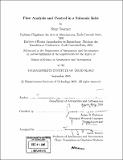| dc.contributor.advisor | James D. Paduano. | en_US |
| dc.contributor.author | Tournier, Serge (Serge E.) | en_US |
| dc.contributor.other | Massachusetts Institute of Technology. Dept. of Aeronautics and Astronautics. | en_US |
| dc.date.accessioned | 2008-02-28T16:19:25Z | |
| dc.date.available | 2008-02-28T16:19:25Z | |
| dc.date.copyright | 2005 | en_US |
| dc.date.issued | 2005 | en_US |
| dc.identifier.uri | http://dspace.mit.edu/handle/1721.1/34135 | en_US |
| dc.identifier.uri | http://hdl.handle.net/1721.1/34135 | |
| dc.description | Thesis (S.M.)--Massachusetts Institute of Technology, Dept. of Aeronautics and Astronautics, 2005. | en_US |
| dc.description | Includes bibliographical references (leaves 109-113). | en_US |
| dc.description.abstract | S-duct inlets are commonly used on subsonic cruise missiles, as they offer a good compromise between compactness, low observability and aerodynamic performance. Though currently used S-ducts exhibit good performance in terms of distortion and pressure recovery at the AIP, the situation can degrade drastically when the inlet is put in off-design conditions, with the risk of compressor instabilities. Flow control is considered as a promising way to maintain inlet efficiency in off-design flight conditions. Industrial interest for flow control techniques is therefore rising, and a need for their comparative evaluation has been expressed. In response to this need, an experimental setup has been designed and fabricated, and flow control experiments have been carried out at MIT, on the selected off-design case of forebody boundary layer ingestion. The first set of experiments focused on the characterization of the inlet in a clean configuration. Then, a distortion device was added in order to simulate thick forebody boundary layer. This proved to have a strong detrimental effect on the inlet performance, as the separation bubble grew in size, the pressure recovery dropped down and the distortion level increased drastically. The selected flow control techniques were then implemented. . | en_US |
| dc.description.abstract | (cont.) The Vortex Generators, tried in different configurations, did improve the pressure recovery and significantly decrease the distortion level. They had a strong impact on the flow structure, delaying or even suppressing separation. Injection was done with Coanda-type injectors, upstream of the separation line. Steady injection led to significant improvement of the pressure recovery, which increased with increasing injection mass flow. Separation was eliminated at least for the highest injection mass flows. The distortion level decreased with increasing injection mass flow. Overall, the results also highlighted the importance of the secondary flows as a source of distortion and pressure recovery loss | en_US |
| dc.description.statementofresponsibility | by Serge Tournier. | en_US |
| dc.format.extent | 141 leaves | en_US |
| dc.language.iso | eng | en_US |
| dc.publisher | Massachusetts Institute of Technology | en_US |
| dc.rights | M.I.T. theses are protected by copyright. They may be viewed from this source for any purpose, but reproduction or distribution in any format is prohibited without written permission. See provided URL for inquiries about permission. | en_US |
| dc.rights.uri | http://dspace.mit.edu/handle/1721.1/34135 | en_US |
| dc.rights.uri | http://dspace.mit.edu/handle/1721.1/7582 | |
| dc.subject | Aeronautics and Astronautics. | en_US |
| dc.title | Flow analysis and control in a subsonic inlet | en_US |
| dc.type | Thesis | en_US |
| dc.description.degree | S.M. | en_US |
| dc.contributor.department | Massachusetts Institute of Technology. Department of Aeronautics and Astronautics | |
| dc.identifier.oclc | 67770114 | en_US |
